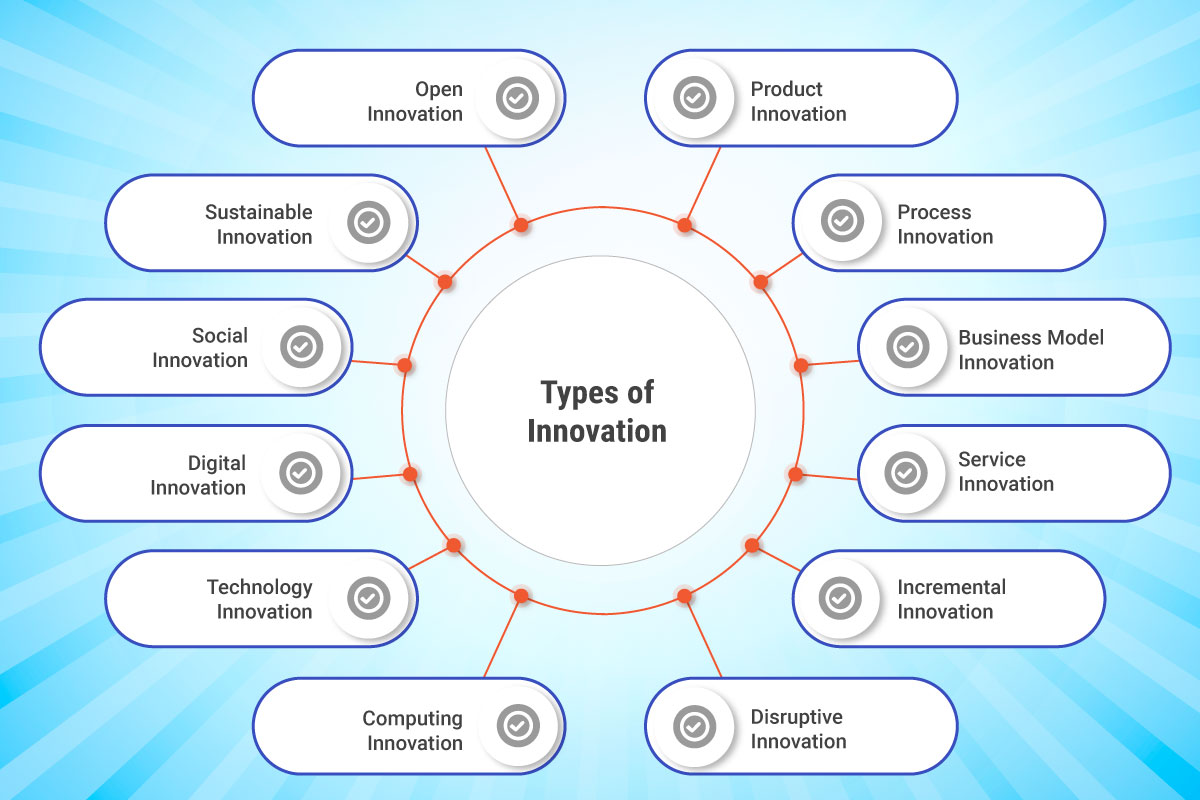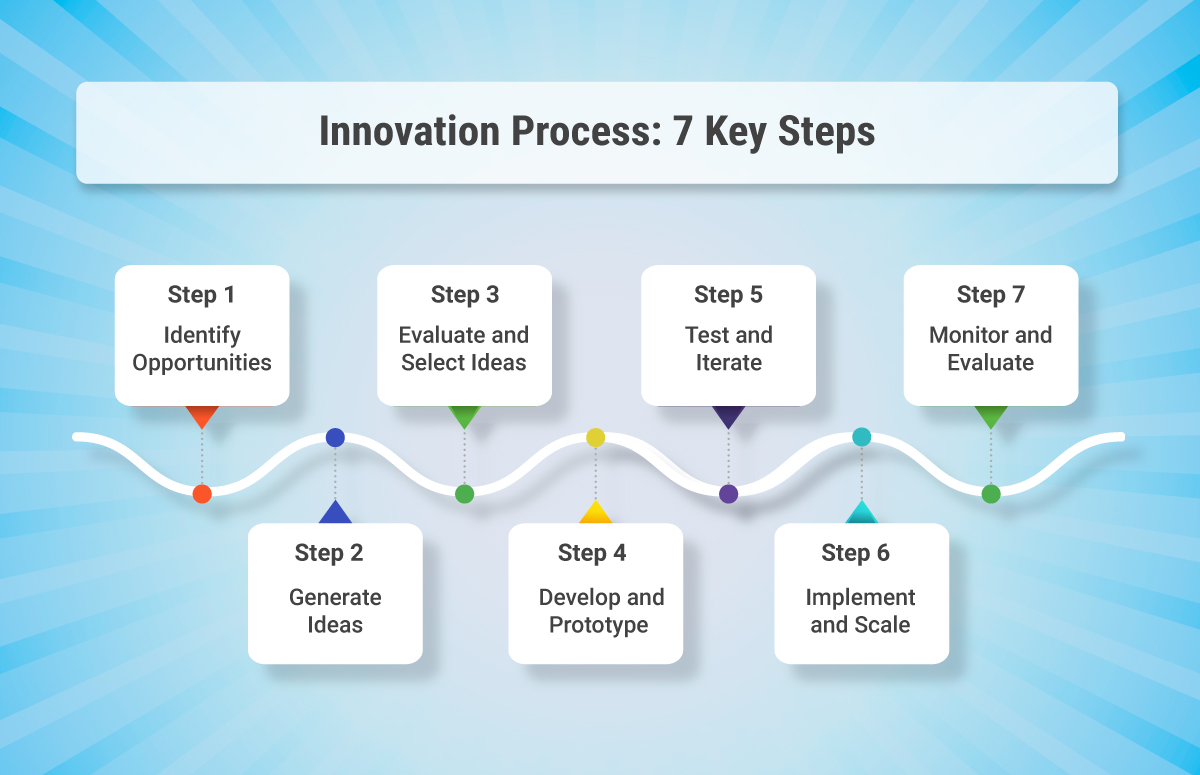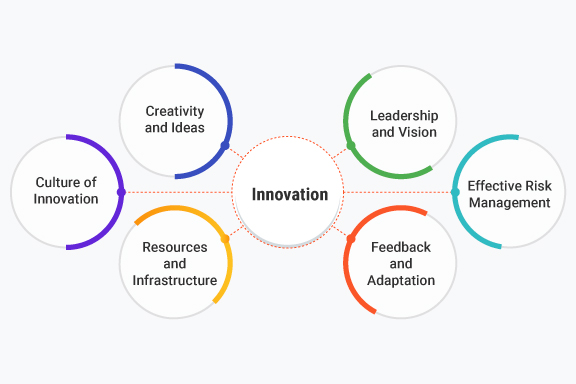Table of Contents
What is Innovation?
Innovation is defined as the process of bringing about new ideas, methods, products, services, or solutions that have a significant positive impact and value. It involves transforming creative concepts into tangible outcomes that improve efficiency, and effectiveness, or address unmet needs.
Innovation is not limited to technological advancements and encompasses novel approaches to problem-solving, processes, organizational practices, or business model innovations. At its core, innovation involves challenging the status quo, thinking outside the box, and taking calculated risks to drive progress and achieve breakthrough outcomes.
Innovation is driven by a combination of factors, including curiosity, creativity, and the desire for improvement. It requires a mindset that embraces change, welcomes ideation, and encourages experimentation. Innovation can occur in various contexts, such as business, science, technology, social sectors, or public services. It can lead to economic growth, social progress, improved quality of life, and sustainable development.
Key components that make innovation possible in an organization
Several key components contribute to making innovation possible in an organization. These components provide the foundation and enable organizations and individuals to drive innovation effectively. Here are the key essential components:
- Creativity and Ideas: Creativity is the fuel for innovation. It involves generating new and original ideas, challenging assumptions, and thinking beyond conventional boundaries. It is the ability to connect disparate concepts and envision novel possibilities. The generation of diverse ideas, both incremental and disruptive, serves as the starting point for innovation.
- Culture of Innovation: An organizational culture that fosters and supports innovation is crucial. It includes values, attitudes, and behaviors that encourage curiosity, risk-taking, collaboration, and experimentation. A culture of innovation promotes an open and inclusive environment where individuals feel empowered to contribute their ideas and embrace change.
- Resources and Infrastructure: Adequate resources, both financial and non-financial, are essential for innovation. This includes dedicated funding, skilled human capital, technology infrastructure, research and development capabilities, and access to relevant information and data. Organizations need to allocate resources strategically to support innovation initiatives.
- Leadership and Vision: Effective leadership plays a vital role in driving and supporting innovation. Leaders set the vision, create a sense of purpose, and provide guidance and resources for innovation initiatives. They foster an environment that encourages risk-taking, empowers employees, and leads by example. Leadership commitment and support are crucial in nurturing a culture of innovation and driving innovation efforts.
- Feedback and Adaptation: Innovation requires a feedback loop that allows for continuous innovation. Feedback can come from customers, users, stakeholders, and market trends. Organizations need mechanisms to gather and analyze feedback, learn from successes and failures, and iterate on their innovation initiatives. The ability to adapt and pivot based on feedback is essential to refine and enhance innovative solutions.
- Effective Risk Management: Innovation involves inherent risks and uncertainties, which makes effective risk management crucial to mitigate potential challenges and ensure successful outcomes. Organizations need processes to identify, assess, and manage risks associated with innovation initiatives. This includes evaluating the feasibility, viability, and potential impact of innovative ideas and implementing risk mitigation strategies.
Learn more: What is Business Innovation?
Types of Innovation

Innovation can take various forms, and different types of innovation serve different purposes and bring different benefits. Here are the key types of innovation:
- Product Innovation: Product innovation involves developing new or improved products or services. It can include innovations in functionality, features, design, performance, or packaging. It aims to create value for customers by addressing their needs, solving problems, or introducing novel and desirable offerings.
- Process Innovation: Process innovation focuses on improving the efficiency, effectiveness, or quality of internal processes within an organization. It involves rethinking and redesigning workflows, technologies, and systems to streamline operations, reduce costs, enhance productivity, or improve the delivery of products or services. Process innovation often leads to increased operational efficiency and competitive advantage.
- Business Model Innovation: Business model innovation involves rethinking and redesigning the fundamental ways in which an organization creates, delivers, and captures value. It explores new approaches to revenue generation, cost structure, distribution channels, partnerships, customer engagement, or value proposition. Business model innovation can disrupt industries, create new markets, or enable organizations to differentiate themselves from competitors.
- Service Innovation: Service innovation involves developing new or improved services, delivery methods, or customer experiences. It focuses on enhancing the value and satisfaction customers derive from service interactions. Service innovation can include innovations in service design, customization, accessibility, convenience, or personalization. It aims to meet evolving customer expectations and create a competitive edge.
- Incremental Innovation: Incremental innovation refers to small, gradual improvements made to existing products, services, or processes. It involves making iterative changes, optimizations, or enhancements to existing offerings. Incremental innovation is often characterized by a focus on continuous improvement, efficiency gains, or evolutionary advancements. It can help organizations stay competitive, maintain market relevance, and refine their offerings over time.
- Disruptive Innovation: Disruptive innovation refers to the creation of new products, services, or business models that disrupt existing markets or industries. It introduces novel solutions that fundamentally change the way value is created, delivered, or consumed. Disruptive innovations often start in niche markets or with underserved customers, and they gradually gain traction and displace established players.
- Open Innovation: Open innovation involves collaborating with external partners, such as customers, suppliers, research institutions, or startups, to generate new ideas, share knowledge, or co-create innovative solutions. Open innovation recognizes that valuable ideas and expertise exist beyond an organization’s boundaries and seeks to leverage external resources and insights to drive innovation.
- Sustainable Innovation: Sustainable innovation is the process of developing and implementing new products, services, technologies, or business models that have a positive environmental, social, and economic impact. It involves finding creative and efficient solutions to address pressing challenges, such as climate change, resource depletion, pollution, inequality, and poverty.
- Social Innovation: Social innovation is the development and implementation of novel solutions to address social, cultural, economic, or environmental challenges. It involves the creation and adoption of new ideas, products, services, or approaches that result in positive societal impact and sustainable change.
- Digital Innovation: Digital innovation refers to the application of digital technologies and advancements to create new or improved products, services, processes, or business models. It involves leveraging digital tools, platforms, data, and connectivity to drive innovation and transform traditional practices.
- Technology Innovation: Technology innovation refers to the creation, adoption, and utilization of new or improved technologies to drive progress and improve outcomes in various domains. It encompasses advancements across a wide range of technological fields, including but not limited to information technology, biotechnology, renewable energy, nanotechnology, robotics, materials science, and telecommunications.
- Computing Innovation: Computing innovation pertains to advancements and breakthroughs in the field of computing and information technology. It involves the development and application of new hardware, software, algorithms, and computational approaches to solve complex problems, enable new capabilities, or improve existing systems.
Furthermore, any of the above types of innovation can be approached through continuous innovation or discontinuous innovation:
- Continuous Innovation: Continuous innovation refers to incremental improvements or enhancements made to existing products, services, processes, or business models. It involves making small, gradual changes over time to refine and optimize existing offerings. Continuous innovation aims to improve efficiency, quality, or user experience without fundamentally altering the underlying concept or value proposition. It is often driven by feedback from customers, market insights, and the organization’s desire to stay competitive. Continuous innovation helps organizations maintain their market position, meet evolving customer expectations, and sustain long-term growth.
- Discontinuous Innovation: Discontinuous innovation, also known as radical or disruptive innovation, involves introducing significant and transformative changes that disrupt existing markets, business models, or ways of doing things. It represents a departure from the existing norms and practices and often involves the introduction of entirely new products, services, technologies, or business models. Discontinuous innovation can create new market segments, open up new possibilities, and challenge established players. It is characterized by a higher level of risk, uncertainty, and potential rewards. Discontinuous innovation is driven by identifying and capitalizing on emerging trends, technological advancements, or changing customer needs.
These types of innovation and the two approaches are not necessarily mutually exclusive, and organizations often engage in multiple types simultaneously to create a comprehensive innovation strategy. The choice of which type and approach to pursue depends on the organization’s goals, industry dynamics, customer needs, and the potential for value creation and differentiation.
Innovation Examples: 10 Best Across Industries
Here are the ten best innovation examples from various industries:
1. Airbnb: Airbnb disrupted the traditional hospitality industry by creating an online marketplace that allows individuals to rent out their homes or spare rooms to travelers. This peer-to-peer accommodation model provided an alternative to traditional hotels and revolutionized the way people travel and experience accommodations.
2. Electric Vehicles: Electric vehicles by brands like Tesla, have revolutionized the automotive industry by pioneering electric vehicles (EVs) that offer long-range capabilities, high-performance features, and sustainable energy solutions. Their technology innovation in battery and charging infrastructure has played a significant role in accelerating the adoption of EVs worldwide.
3. SpaceX’s Reusable Rockets: SpaceX, founded by Elon Musk, developed reusable rockets that can be landed and reused, significantly reducing the cost of space exploration and making space travel more accessible. This innovation has opened up new possibilities in the aerospace industry.
4. 3D Printing: 3D printing, also known as additive manufacturing, has transformed various industries by enabling the production of complex and customized objects with precision. It has revolutionized manufacturing, healthcare (e.g., prosthetics), and design prototyping, among other sectors.
5. CRISPR Gene Editing: CRISPR-Cas9 is a revolutionary gene-editing technology innovation that enables precise and efficient modification of DNA sequences. This innovation has the potential to revolutionize healthcare, agriculture, and biotechnology by offering new approaches to treating genetic diseases, enhancing crop resilience, and developing new therapies.
6. Netflix’s Streaming Service: Netflix disrupted the traditional video rental and television industry by introducing a streaming service that allows users to watch movies and TV shows on demand. This innovation led to a shift in how content is consumed, paving the way for other streaming platforms.
7. Mobile Payment Solutions: Companies like Apple Pay, Google Pay, and PayPal have transformed the way payments are made by enabling secure and convenient mobile transactions. This innovation has simplified payment processes and enhanced financial inclusivity.
8. Amazon’s Alexa Voice Assistant: Amazon’s voice-controlled assistant, Alexa, introduced a new way of interacting with technology leveraging digital innovation through natural language processing. It has revolutionized the smart home industry and paved the way for voice-controlled devices and services.
9. Electric Scooters and Bike-Sharing Services: Electric scooters and bike-sharing services, such as Lime and Citi Bike, have provided eco-friendly alternatives for urban transportation. These innovations have facilitated short-distance travel, reduced congestion, and promoted sustainable mobility options.
10. Solar Energy Technologies: Advancements in solar energy technologies, including more efficient photovoltaic cells and cost reductions, have made solar power increasingly accessible and economically viable. This innovation has driven the growth of renewable energy sources and contributed to the transition towards a sustainable energy future.
These examples showcase the transformative power of innovation across various sectors, highlighting how ideation and advancements can reshape industries, improve lives, and drive positive change.
Learn more: What is Innovation Management?
Innovation Process: 7 Key Steps

The innovation process typically involves a series of key steps that organizations follow to foster and implement innovation. While specific approaches may vary, here are the common steps involved in the innovation process:
Step 1. Identify Opportunities
The first step is to identify opportunities for innovation. This can be done through market research, customer insights, trend analysis, or internal assessments. The goal is to uncover unmet needs, emerging trends, or areas for improvement that can be addressed through innovation.
Step 2. Generate Ideas
Once opportunities are identified, the next step is to generate ideas. This can be done through brainstorming sessions, idea competitions, customer feedback, or cross-functional collaboration. The aim is to generate a wide range of creative and innovative ideas that have the potential to address the identified opportunities.
Step 3. Evaluate and Select Ideas
After ideation, the next step is to evaluate and select the most promising ones. This involves assessing the feasibility, viability, and desirability of each idea. Consider factors such as market potential, technical feasibility, resource requirements, alignment with strategic goals, and potential impact. The goal is to identify the ideas that are worth pursuing further.
Step 4. Develop and Prototype
Once ideas are selected, they can be further developed and prototyped. This involves translating the selected ideas into tangible prototypes, mock-ups, or minimum viable products (MVPs). The aim is to test and validate the concepts, gather feedback, and refine the ideas based on customer insights and technical feasibility.
Step 5. Test and Iterate
In this step, the prototypes or MVPs are tested with users or in real-world scenarios. Customer feedback is collected, and the concepts are iterated and refined based on the insights gained. This iterative process helps to validate assumptions, uncover potential issues, and improve the innovation before moving to the next stage.
Step 6. Implement and Scale
Once the innovation has been tested and refined, it can be implemented and scaled up. This involves developing a detailed implementation plan, allocating resources, and executing the necessary actions to bring the innovation to market or implement it within the organization. The goal is to ensure a smooth transition from the development phase to full-scale implementation.
Step 7. Monitor and Evaluate
After implementation, it is important to monitor and evaluate the performance and impact of the innovation. This involves tracking key metrics and performance indicators to assess the success of the innovation. Regular evaluation helps identify areas for improvement, make necessary adjustments, and capture learnings for future innovation initiatives.
Innovation is an ongoing process, and organizations should foster a culture of innovation. This involves capturing feedback, promoting learning from both successes and failures and continuously seeking new opportunities for innovation. Regularly revisiting and refining the innovation process itself is also essential to optimize the organization’s ability to innovate effectively.
Learn more: What is Innovation Strategy?

